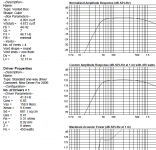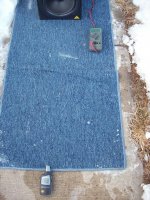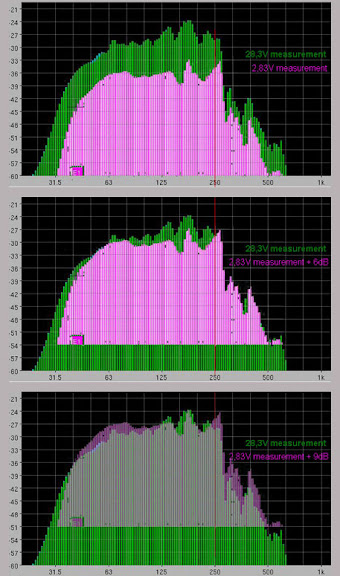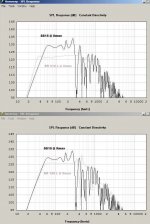nope... so you want to take that reading and multiply by .707?
Voltage Conversions
Peak= 1.414*RMS
RMS= .707*Peak or Avg*1.11
Avg= .637*RMS
With sine waves only.
Last edited:
Voltage Conversions
Peak= 1.414*RMS
RMS= .707*Peak or Avg*1.11
Avg= .637*RMS
With sine waves only.
Any time I post a spl measurement, it's always volt meter, sine wave, and spl meter, 28v10m.
Beckman is the poor mans fluke... I have great confidence in it.
Maybe runrod's 111db measurements aren't as far off as I thought..... hmmm.....
A dB meter reports level at the frequencies that are loudest, the response peaks around 160 and 260 Hz are 3 dB above the 55-120 Hz range.nope... so you want to take that reading and multiply by .707?
That'll make the numbers look even better....
That was at the end of my sidewalk... about 20' from the house, nothing in front for about a half mile. You can see the toyota off to one side, that's about it.
The pic a few posts back (#331) was 28v10m, I don't see much difference to what I did today.
excuse the 'non-scientific' measurement that was obviously rushed.... it was cold, and snowy, but at least no wind.
An unweighted SPL reading of 105.4 would put the response in the pass band of 55-120 around 102.4 dB, about three dB more than a similar sized ported box with the same speaker .
Even with a calibrated dB meter, the calibration only insures the dB meter is accurate at the test tone frequency, usually 1K, a decade away from sub frequencies.
A relatively small meter (or test voltage) error could mean the box actually has little or no advantage over a ported design of similar size.
I found measuring about 6 feet away from outdoor buildings lifted the response of subs by 4 dB in the octave around 40 Hz, not sure what influence walls 20 feet away would have, but the wall being within a wavelength of the DUT will definitely have some effect. Even small objects by the test microphone can have several dB influence.
Using the magnitude response will show coherence, very helpful to see if what you are testing is valid.
Windscreens are a must outside too, just do an indoor measurement with it on and off to find if it affects the response. The standard ones I use have virtually no effect on frequency response, but make all the difference when testing outside.
Getting reliable measurements without a known benchmark is virtually impossible, the reason I asked l the questions in post #334 and 339.
The comparative tests I posted in #339 were an eye opener for me, I would have thought the front loaded and tapped horns would have performed better than they did, but the JBL SRX 728 proved otherwise, it is 98 dB one watt one meter in the 80 Hz range
Don’t want to sound like a “doubting Thomas” but until I see a relative comparison, I find it hard to accept test results, including my own. I went through a period of frustration building and testing dozens of boxes (and freezing my what off), finding they fell far short of predicted results, only to later find the test microphone I was using read way low in the low frequencies.
I hope you will mount a 3015LF in a standard box, or better yet the one like below (well under one sheet :^) ), and do a comparison to the tapped horn.
Thanks !
Attachments
Here's a behringer 2031p... with well published specs. It's 89db 1w1m 4ohm. So... 2v should get something close to 89db.
well I'm within 2db of their published spec... on the cheap-o spl meter using the EXACT same setup as I did with the ss15.
now it's cold... I'm not dragging this stuff back out in the cold again.
well I'm within 2db of their published spec... on the cheap-o spl meter using the EXACT same setup as I did with the ss15.
now it's cold... I'm not dragging this stuff back out in the cold again.
Attachments
Last edited:
I don’t blame you for not wanting to do more testing, I have not been out in my shop for days due to the cold.Here's a behringer 2031p... with well published specs. It's 89db 1w1m 4ohm. So... 2v should get something close to 89db.
well I'm within 2db of their published spec... on the cheap-o spl meter using the EXACT same setup as I did with the ss15.
now it's cold... I'm not dragging this stuff back out in the cold again.
Sensitivity specs without charts are always suspect, but let’s pretend the Behringer spec is correct and the response is dead flat, and the proximity to buildings are having no effect on your readings.
I have not done that much pretending since I was a kid, this is fun!
So your meter reads 2 dB too high
It reads 105.4 dB on the higher peaks of the one sheet sub, which are at least 3 dB above the range it is used in, so that puts the sensitivity at about 102 dB .
102 dB - the 2 dB meter variance =100 dB.
The 3015LF is almost exactly that sensitivity in a ported box of similar size.
Oh well
I don’t blame you for not wanting to do more testing, I have not been out in my shop for days due to the cold.
Sensitivity specs without charts are always suspect, but let’s pretend the Behringer spec is correct and the response is dead flat, and the proximity to buildings are having no effect on your readings.
I have not done that much pretending since I was a kid, this is fun!
So your meter reads 2 dB too high.
It reads 105.4 dB on the higher peaks of the one sheet sub, which are at least 3 dB above the range it is used in, so that puts the sensitivity at about 102 dB .
102 dB - the 2 dB meter variance =100 dB.
The 3015LF is almost exactly that sensitivity in a ported box of similar size.
Oh well.
uh.... no. not even close.
uh.... no. not even close.
Certainly the response above 125 Hz of the tapped horn will not be close, but below 125 Hz, your tests are not supporting your statement.
Should be easy enough for you to prove or disprove, perhaps you will do a test with the same speaker to verify how close or far apart the response is.
Based on what you have posted, my money is on a pretty close (within 2 dB) level between a ported cabinet and the tapped horn 45-125 Hz.
I hope you prove me wrong, I want to believe !
Hi jbell,
It's probably of little use to continue this discussion until you or somebody else can take direct comparative measurements, that would also include actual observation of Xmax @ high power to see what is really happening inside a tapped horn, and then there is still the difference in the way these boxes would actually sound. If I were you I'd stay out of the cold.
I just put a "box of similar size" into Hornresp as a BR, and compared it to the tapped horn, a more appropriately sized box would be around 100 L_net (2nd SPL graph).
For what it's worth:
Regards,
It's probably of little use to continue this discussion until you or somebody else can take direct comparative measurements, that would also include actual observation of Xmax @ high power to see what is really happening inside a tapped horn, and then there is still the difference in the way these boxes would actually sound. If I were you I'd stay out of the cold.
I just put a "box of similar size" into Hornresp as a BR, and compared it to the tapped horn, a more appropriately sized box would be around 100 L_net (2nd SPL graph).
For what it's worth:
Regards,
Attachments
Jbell, a measurement with phase, spl and coherence, would be awesome, and just the way Tom Danley has published charts.
and of course the fact that we yet have impedance charts seems very strange considering the effects of bracing, leaks etc are much easier to evaluate with such a chart.
and of course the fact that we yet have impedance charts seems very strange considering the effects of bracing, leaks etc are much easier to evaluate with such a chart.
The new subwoofer testing site I have been hinting around about in now live, and I can be shared!
Data-Bass
You will find some good stuff here from the first round of testing, and as soon as it stops snowing there will be a new round of testing with new horns, and even more measurements.
Data-Bass
You will find some good stuff here from the first round of testing, and as soon as it stops snowing there will be a new round of testing with new horns, and even more measurements.
The new subwoofer testing site I have been hinting around about in now live, and I can be shared!
Data-Bass
You will find some good stuff here from the first round of testing, and as soon as it stops snowing there will be a new round of testing with new horns, and even more measurements.
Nice site! However, I think that, for the driver tests, you should include published specs as well as measured specs. Let's see whose marketing department got a hand on the parameters
Hi jbell,
It's probably of little use to continue this discussion until you or somebody else can take direct comparative measurements, that would also include actual observation of Xmax @ high power to see what is really happening inside a tapped horn, and then there is still the difference in the way these boxes would actually sound. If I were you I'd stay out of the cold.
I just put a "box of similar size" into Hornresp as a BR, and compared it to the tapped horn, a more appropriately sized box would be around 100 L_net (2nd SPL graph).
For what it's worth:
Regards,
Trade-offs seem to be similar to those of bandpass alignments - you get get greater extension, or high efficiency. With my POC#2, sims suggest a few dB of higher sensitivity compared to a vented alignment, but of course the box is bigger too. Then of course there's the difference at high SPLs to be considered as well.
Hi soho54,
Great site, very well done and informative. I'm missing the 1m/2.83V small signal measurement though. It's still a good comparative curve. Also, it would be nice to have the full T/S data set (found it, it's on the driver page ).
).
Good luck with this endeavour, Regards,
Great site, very well done and informative. I'm missing the 1m/2.83V small signal measurement though. It's still a good comparative curve. Also, it would be nice to have the full T/S data set (found it, it's on the driver page
Good luck with this endeavour, Regards,
Last edited:
you show me the horn resp of your ported cab vs the ss15....
I don’t have Hornresponse, but I already posted the Kappalite 3015LF Med Vented PA Subwoofer Cabinet by Jerry McNutt, Eminence speaker LLC in post #343.
Jerry has published plans for most of the Eminence speakers, I have found them to work fine, and agree well to real world results.
His 4.091 Vb 44Hz Fb box has 125 dB + output, as does the second Hornresponse ported box Tb46 posted in #351, which also includes a sim of your SS15.
On paper, the ported boxes and the SS15 are within 3 dB in the sub range.
By interpolating your test results and possible 2 dB spl difference that your test of the Behringer 89 dB spl cabinet you read as 91 dB, looks like the actual SS15 build may be almost exactly the same in the 45-120 Hz range as a front loaded box.
I agree with Tb46 that we won’t know how the real box performs in terms of actual SPL until someone takes direct comparative measurements.
2nd round of tests.
Ok, so the cab is now sealed up and braced as per Jbell's design. After this test I don't think anymore bracing is necessary. I neglected to mention the speaker was in fact a Kappa3015lf.
Test done just like the last one, 2.89 volts. (I coulndn't get the volume slider adjusted right on the money like last time). distance of 1 meter, ratshack digital meter. Meter pointed at center off horn mouth. Test was oudoors on asphalt. I exptended the freq. range this time to see where it would drop off.
the results:
40hz 101db
45hz 104
50hz 107
55hz 110
60hz 111
65hz 111
70hz 112
75hz 112
80hz 111
85hz 109
90hz 111
95hz 111
100hz 111
105hz 111
110hz 112
115hz 113
120hz 114
125hz 114
130hz 114
135hz 114
140hz 114
145hz 113.
150hz 111
155hz 109
160hz 108
165hz 105
Monday the neighbors will be at work and i'll do a 28volt test.
If someone will explain to me how it's done, I will do a test to find out the drop off at various distances from the box. i'm interested to see if the box follows the inverse law from the speaker, or from the mouth of the cab.
regard,
jeff
Ok, so the cab is now sealed up and braced as per Jbell's design. After this test I don't think anymore bracing is necessary. I neglected to mention the speaker was in fact a Kappa3015lf.
Test done just like the last one, 2.89 volts. (I coulndn't get the volume slider adjusted right on the money like last time). distance of 1 meter, ratshack digital meter. Meter pointed at center off horn mouth. Test was oudoors on asphalt. I exptended the freq. range this time to see where it would drop off.
the results:
40hz 101db
45hz 104
50hz 107
55hz 110
60hz 111
65hz 111
70hz 112
75hz 112
80hz 111
85hz 109
90hz 111
95hz 111
100hz 111
105hz 111
110hz 112
115hz 113
120hz 114
125hz 114
130hz 114
135hz 114
140hz 114
145hz 113.
150hz 111
155hz 109
160hz 108
165hz 105
Monday the neighbors will be at work and i'll do a 28volt test.
If someone will explain to me how it's done, I will do a test to find out the drop off at various distances from the box. i'm interested to see if the box follows the inverse law from the speaker, or from the mouth of the cab.
regard,
jeff
Real speakers don't exist on paper and they certainly don't reside inside a computer.On paper, the ported boxes and the SS15 are within 3 dB in the sub range
Real speakers get hot and compress. Real ports run out of velocity and compress.
The computer sims that we love so much are only a guide.
What J Bell shares with us is practical real world experience, and this is confirmed by the experience of others who are confident enough to try his designs.
As for only 3dB, well I would love to be able to add 3dB to my reflex cabinets. The only way I know how to do this is add another speaker.
I don’t have Hornresponse, but
looks like oliver was right, we don't have much to talk about.
and btw... the b2013p that I measured is 2 years old and WELL broken in... (lots of rockband...) I didn't happen to have a brand new one available, but I've measured them before and been within a half db of the measured chart that comes with them.
Real speakers don't exist on paper and they certainly don't reside inside a computer.
Real speakers get hot and compress. Real ports run out of velocity and compress.
The computer sims that we love so much are only a guide.
What J Bell shares with us is practical real world experience, and this is confirmed by the experience of others who are confident enough to try his designs.
As for only 3dB, well I would love to be able to add 3dB to my reflex cabinets. The only way I know how to do this is add another speaker.
AND.... the real game changer here.... TH's are directional.... I've measured up to 12db front to back. Which explains why I LOVE the 28v10m test.....
Makes a BR vs TH comparison, like bringing a knife to a gun fight.
- Home
- Loudspeakers
- Subwoofers
- Single sheet TH challenge



